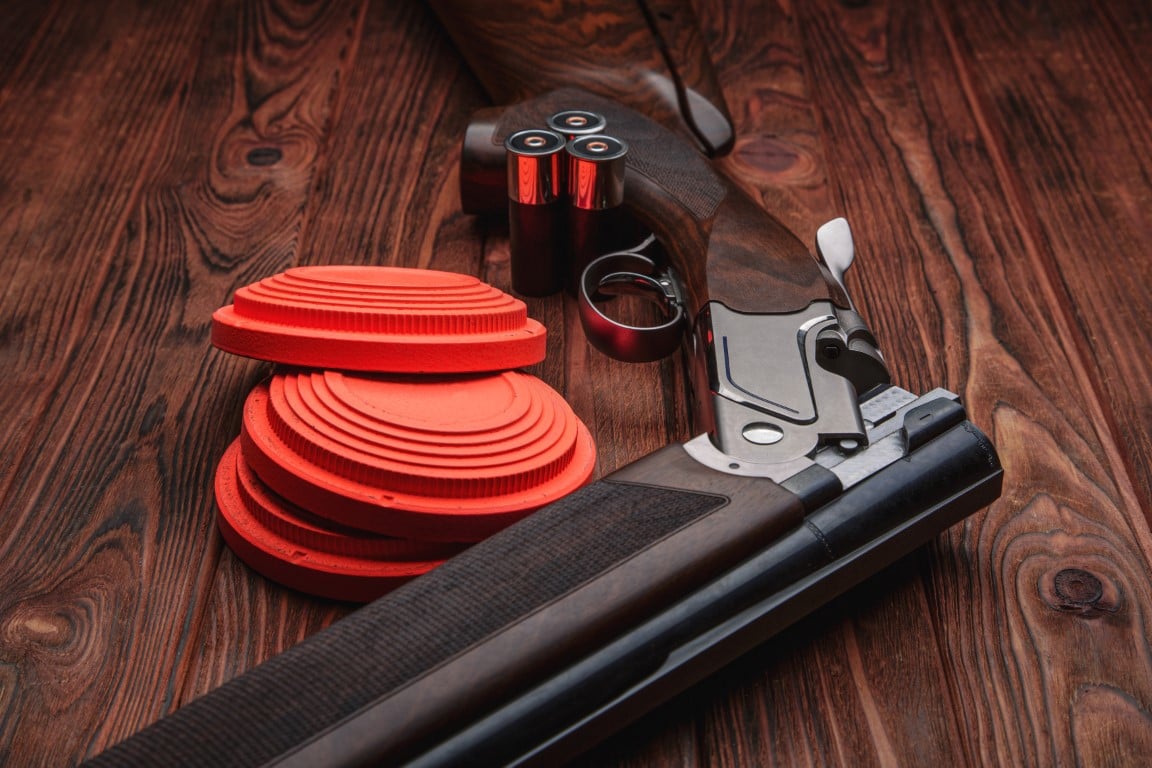Sporting clays is often called “golf with noise.” But instead of a course with fairways, greens, sand traps, water hazards, and holes, sporting clays participants move from station to station, where they are presented with a variety of targets designed to simulate gamebirds in flight. Unlike trap and skeet—games in which the targets are always set at unvarying angles—each sporting clays station presents a different challenge, depending on how the course is set up. You may find yourself trying to pick up a fast-moving target as it exits a trap hidden in the woods, spot a high incomer drifting through the trees, or break a target designed to imitate a springing teal as it jumps straight up in front of you. Sound challenging? It is. It’s also fun.
Given the complexity of the game, this tutorial can’t cover every aspect. Instead, my intent is to give you some basic tips to help you get started.
Gun Speed
Although sporting clay targets are designed to mimic gamebirds in flight, there is a big difference between birds and clays. When a gamebird lifts off the ground to escape danger, it is an accelerating target; no matter how fast a clay bird is released, it is a decelerating target. This is an important distinction and one of the reasons beginners miss so many targets. The key here is to match gun speed to the speed of the target. There’s no magic formula—it takes practice.
The Mount
Sporting clays is a low-mount sport, meaning you begin with the shotgun held out in front of you, off the shoulder. When you call to release the target, you need to see the bird, mount the gun, and pull the trigger. Easier said than done. The biggest fault in most shooters is poor gun mount. They look at the gun’s barrel, bring the gun up, and lower their head to the stock. That’s wasted motion. By the time you finally get on target, the bird is sailing away.
You should never take your eye off the bird. Here’s a drill designed to help improve your gun mount while focusing on the target. Take a small Maglite flashlight, wrap tape around the tube, and insert it into the muzzle of an unloaded shotgun. (The tape protects the choke tube from abrasion.) In a darkened room, turn on the flashlight. Pick a corner of the ceiling and point the light at the crease between the ceiling and the wall. Move the light as if you are tracking a target and bring the gun to your shoulder without looking at the barrel. If the light falls off the prescribed line, you’re doing it wrong. What you’re after is a smooth mount that doesn’t disturb the path of the light.
Shotgun instructor Gil Ash, who taught me this move, says it takes thousands of reps to ingrain this muscle memory. Most shooters won’t go the distance here, but even if you do it a few hundred times at home, it will help improve your form.
The Bird, Not the Barrel
Another common mistake made by new shooters is focusing on the end of barrel (or the bead), not the bird. Poor gun mount exacerbates the problem. If you take your eyes off the bird, you lose precious seconds trying to reacquire the target, which by then is most likely out of range. I was using the barrel to check my lead, which only amplified my poor mount. Here’s where spending time with an instructor pays a big dividend.
Practice Makes Perfect
Gil Ash once told me, “Practice takes courage.” By that he meant that all too often, practice for many was nothing more than hitting the targets they know they can break. That’s not practice. Real practice is standing there missing the target time after time until you figure out how to break it. If your gun club has a Five Stand layout (basically a compressed sporting clays course), pick the target that gives you trouble, and call for it over and over until you figure out how to break it.
Double Trouble
Though each sporting clays course is different, most often at each station you will shoot singles, report doubles (the second bird is released at the sound of your shot), and true doubles (both birds are released at the same time). Doubles cause a lot of anxiety for new shooters. Two things to keep in mind: Always shoot the outgoing bird first, then focus on the incoming bird. Second, after you break the first bird, move your eyes (not the gun) immediately to pick up the second bird. That done, swing the gun to the target. If you move the gun first, you’re often obscuring the target—one reason so many second birds are lost.
Conclusion
Sporting clays is a challenging shotgun game that involves a high degree of hand-eye coordination and practice to become an accomplished shot. It’s also a lot of fun. Mastering a few basic skills will get you in the game.
Shop Hunting & Target Shotguns
FAQs
Q: What chokes should I use for sporting clays?
A: Most sporting clays participants use an over/under shotgun, in which they insert two different chokes, depending on the particular targets they will face at a particular station. Typically, they may opt for Improved Modified (for closer targets) and Modified (for farther targets). This is a general guide, as shooters have their own individual preferences. But a common fault is to keep changing chokes in the hope that your score will improve. If you can’t hit the bird to begin with, changing chokes won’t help.
Q: Can I shoot sporting clays with a pump or semi-auto shotgun?
A: Yes. However, pump shooters are at a distinct disadvantage on doubles because of the extra motion of working the pump to load a second shell. Semi-autos work just fine, though you’re limited to a single choke choice. That said, I have seen good semi-auto shots run a station (meaning they break all the targets).
Q: I have trouble hitting crossing shots. What am I doing wrong?
A: Assuming you have established the correct lead, most likely you’re not following through. You need to keep the barrel moving as you pull the trigger. If you stop moving the barrel, you’ll shoot behind the bird. If you happen to be shooting in front of the bird, you’re moving the barrel too fast. Match the speed of the gun to the speed of the target.
Q: No matter how much I practice, I can’t seem to break targets with any consistency. What am I doing wrong?
A: Have you checked for eye dominance? It’s easy. With both eyes open, fully extend both arms, and then bring your thumbs and forefingers together to form a little window. Focus on an object a few feet away. Close one eye and look at the object. Now close that eye and open the other. You’ll notice that one eye centered the object; the other eye did not. The eye that centered the object is your dominant eye. If the dominant eye is your left eye but you shoot right-handed (a not-uncommon occurrence), you’re not pointing the gun where it needs to be. This is called “cross dominance,” and it’s also seen with some shooters who naturally shoot left-handed but are right-eye dominant.
The best fix is to mount the gun on the shoulder under the dominant eye. That said, older shooters find it too difficult to switch sides. Doing so often requires a stock modification as well. So, they’ll close the dominant eye. This solves one problem but creates another—you lose depth perception and half your field of view. In the case of the first example, you may hit more straightway targets and those to your right, but you’ll be late to pick up crossing birds that start from the left. Some cross-dominant shooters place a small piece of scotch tape on the lens of the dominant eye of the shooting glasses. This slightly blurs the target picture and lets the non-dominant eye (the one above the barrel) take control. It’s an imperfect fix, but it works.






